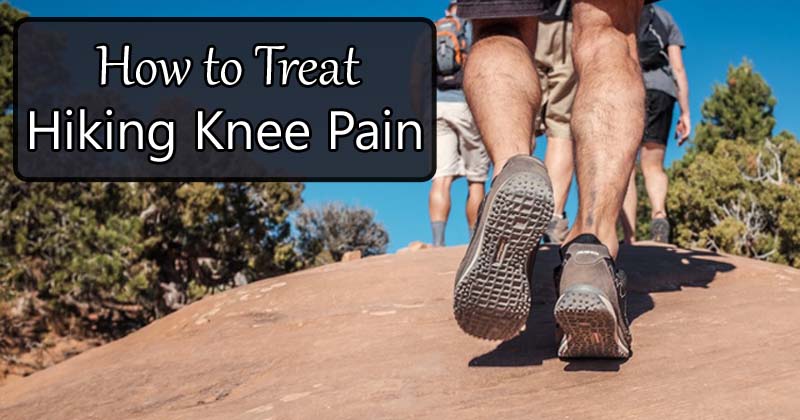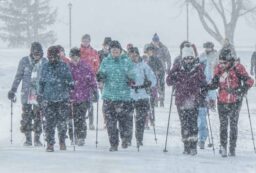Our knees can take quite a beating while hiking. The knee pain sometimes gets so bad that I’ve heard of backpackers who’ve had to walk down hills backwards in order to complete the hike! Here’s what Brent Wells, a practicing chiropractor based out of Alaska, has to say about what causes hiking knee pain and how you can prevent and treat it.
What Causes Knee Pain When Hiking?
Knee pain when hiking can be caused by a few different things. The main culprits are:
Overuse or Strain
As you hike over hills and rocky surfaces, you unknowingly are putting extreme pressure on your lower body. Your knees tend to take the full brunt.
Wrong Shoes
Another common reason you might experience knee pain when hiking is because you’re wearing the wrong shoes. Because your hips and knees are some of the largest joints in your body, they experience most of the impact when you hike. If your shoes don’t properly support your body when doing so, it can make it harder for these joints to withstand the vibrations.
Injury
Stepping incorrectly while hiking can cause your knees to twist, resulting in a sudden injury. The injury might not be obvious right away; sometimes overuse causes smaller tears that don’t cause pain until later.
Types of Knee Pain from Hiking
The type of knee pain you feel after hiking can give you some clues to how to treat it. Bear in mind that there are many types of knee pain – a doctor will have to diagnose it – these are just some of the most common types of knee pain from hiking.
Tendonitis
Feels Like: A sharp, shooting pain or tenderness above or below your kneecap. The knee might also be swollen and have a burning feeling.
What It Is: Tendonitis occurs from tiny tears in the tendons. The tears lead to inflammation. Most of the time tendonitis occurs after an acute injury and results in severe swelling but can also be a repetitive stress injury. It will usually heal on its own, but if chronic, can last for a few weeks. However, you have to be careful as if it doesn’t heal correctly could have serious side effects. Because of this, it’s not advisable to let tendonitis heal on its own.
Patellofemoral Pain Syndrome
Feels Like: A dull, aching pain in the front or behind the kneecap. It usually gets worse when doing certain movements and is also often noticeable when sitting.
What It Is: Also known as hiker’s knee, patellofemoral pain syndrome occurs around the front of your knee typically near the kneecap. The pain is the result of the nerves around the surrounding tissues and muscles incorrectly interpreting pain receptors and causing them to become inflamed. It’s a common problem in hikers because of the consistent climbing motions.
Meniscus Tears
Feels Like: Symptoms of knee meniscus tears include pain when moving the knee, swelling, difficulty bending or fully straightening your knee, and trouble walking.
What Is It: Meniscus tears are the result of a tight twist that causes knee muscles to tear. It sometimes happens to backpackers going down steep hills with heavy backpacks on. If you hear or feel a popping in your knee, it’s probably a meniscus tear.
Bursitis
Feels Like: Knee bursitis typically feels like a mild pain below the joint, though it can be very painful in severe cases. The knee may be tender, warm, and swollen.
What Is It: Bursitis causes the bursae in the knees to become inflamed. The bursa works as a protective pad and is situated at the front of your knee cap. If you consistently do repetitive motions, it can wear down this pad which can lead to inflammation and tenderness.
Ways to Treat Knee Pain
1. Apply Cold
Ice your knee as soon as you finish your hike. The ice lessens blood flow which helps calm inflammation. In addition to this, it slightly freezes nerves which can prevent them from shooting out pain.
You’ll want to keep ice on the area for about 15 minutes at a time. This will give your body time to absorb the cold and cease inflammation. While it will take some time before major results are seen, ice is very effective and can help ensure your knee heals correctly.
If you are backpacking, try dunking your knee into a cold stream instead. Or, if that’s too impractical, you can dunk a towel into the stream and wrap it around your knee instead.
2. Visit a Chiropractor
Another helpful way to treat knee pain is to stop by a chiropractor. A chiropractor will inspect your knee to identify what the problem might be. Once they do so, they’ll get to work trying certain adjustments to relieve pain and fix misaligned joints or bones.
In addition to manipulations, a few chiropractors might also incorporate massage therapy or ultrasounds. Massage therapy can relax aching muscles while ultrasounds will send heat into your knee so it gets enough oxygen and nutrients to heal.
You’ll find that chiropractic care won’t only stop knee pain, but can actually improve your knee’s flexibility. This can be very beneficial in the long run because it will prepare your knee for future hikes.
3. Do Strengthening Exercises
Sometimes knee pain is the result of not correctly training your knees for heavy impact tasks. If you hike, but haven’t prepared your knees for the journey, it will overwhelm them. This could lead to severe knee pain.
A few strengthening exercises you can try are leg lifts, hamstring curls, and chair dips. You might also consider doing cycling, swimming, or yoga.
4. Eat Anti-Inflammatory Food
Typically backpacking and hiking food is loaded with sodium (especially if you are eating freeze-dried meals). Sodium is a major cause of inflammation and can make knee pain worse. Instead, try to eat antioxidant-rich hiking foods, such as berries, turmeric, and mushrooms. Antioxidants reduce swelling and remove free radicals that could be making the pain worse.
Read:
5. Consider Acupuncture
You might also want to consider trying acupuncture. This type of alternative medicine uses small needles in various pressure points to reduce pain and stimulate nerves. In fact, acupuncture has been shown to help relieve many knee ailments, including osteoarthritis. Acupuncture has such powerful results because it releases endorphins (natural painkillers) throughout the area where the needles are.
How to Prevent Knee Pain When Hiking
Once your knee pain has subsided, you might want to consider using some methods to prevent it from recurring.
1. Wear Orthotic Insoles
The right insoles can do wonders for preventing hiking knee pain. Consider going to a podiatrist who can properly fit you. A fit test involves stepping on a special material to make an imprint of your foot. From this imprint, the doctor gets information about your gait and foot, like whether you have high or low arches or an instep.
2. Choose Flatter Hikers
When you go downhill, your knees absorb the impact of your body plus the force from going downhill. This force really takes a toll on your knees: One study found that force on the knee is 7 to 8 time your bodyweight when going downhill. The more you weight – even if your aren’t overweight – the more impact your knees must endure.
3. Use Trekking Poles
Trekking poles have numerous benefits, including preventing knee pain when hiking. Using poles helps you balance so your knees don’t have to work as hard. They also redistribute impact to your upper body, thus saving your knees while helping you get a full-body workout.
Note: Ideally you should use two trekking poles and not just one. Using just one pole might cause you to favor one side of your body, creating even more problems. If you only use one pole, then at least change up hands every once in a while.
Read: The Pros and Cons of Trekking Poles
4. Knee Brace
You might also want to wear a knee brace when hiking. This can stop extra pressure around your knee and help you to brace your body better when moving uphill or downhill. It can also avert knee locking which can put strain on surrounding muscles.
5. Take More Breaks
Knee pain can also be prevented by just taking periodic breaks. This will give your body time to recover and keep you from overworking your knees.
6. Lighten Your Pack
The more weight you are carrying, the more stress your knees will be under. Some of the easiest ways to lighten your pack are to choose more calorie-dense hiking foods and to plan your hike around water sources so you can filter water as you go instead of carrying it with you.
Read: Tips for Going Lightweight
ABOUT THE AUTHOR:
Dr. Brent Wells, D.C. founded Better Health Chiropractic & Physical Rehab and has been a chiropractor for over 20 years. His practice has treated different musculoskeletal and other health problems through physical therapy, chiropractic care, and massage therapy designed to help give long-lasting relief to Anchorage patients.
Dr. Wells is also the author of over 700 online health articles that have been featured on sites such as Dr. Axe, Organic Facts, and Thrive Global. He is a proud member of the American Chiropractic Association and the American Academy of Spine Physicians. And he continues his education to remain active and updated in all studies related to neurology, physical rehab, biomechanics, spine conditions, brain injury trauma, and more.
References
https://pubmed.ncbi.nlm.nih.gov/25258037/
https://link.springer.com/article/10.2165/00007256-199928040-00003
https://onlinelibrary.wiley.com/doi/abs/10.1177/0884533617700353
https://www.walkhighlands.co.uk/Forum/viewtopic.php?f=1&t=81683













Post your comments